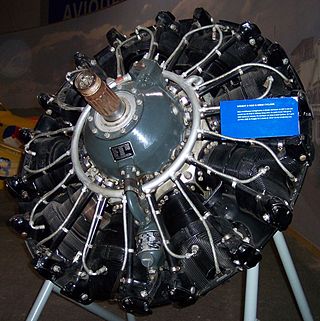
The Dewoitine D.520 is a French fighter aircraft that entered service in early 1940, shortly after the beginning of the Second World War.

The Hispano-Suiza 12Y was an aircraft engine produced by Hispano-Suiza for the French Air Force before the Second World War. The 12Y became the primary French 1,000 hp (750 kW) class engine and was used in a number of famous aircraft, including the Morane-Saulnier M.S.406 and Dewoitine D.520.

The Arsenal VG-33 was one of a series of fast French light fighter aircraft under development at the start of World War II, but which matured too late to see extensive service in the French Air Force during the Battle of France.

The Wright R-1820 Cyclone 9 is an American radial engine developed by Curtiss-Wright, widely used on aircraft in the 1930s through 1950s. It was produced under license in France as the Hispano-Suiza 9V or Hispano-Wright 9V, and in the Soviet Union as the Shvetsov M-25.

The Hispano-Suiza 8 was a water-cooled V8 SOHC aero engine introduced by Hispano-Suiza in 1914, and was the most commonly used liquid-cooled engine in the aircraft of the Entente Powers during the First World War. The original Hispano-Suiza 8A was rated at 140 hp (100 kW) and the later, larger displacement Hispano-Suiza 8F reached 330 hp (250 kW).

The Daimler-Benz DB 600 was a German aircraft engine designed and built before World War II as part of a new generation of German engine technology. It was a liquid-cooled inverted V12 engine, and powered the Messerschmitt Bf 110 and Heinkel He 111 among others.

The Daimler-Benz DB 603 was a German aircraft engine used during World War II. It was a liquid-cooled 12-cylinder inverted V12 enlargement of the DB 601, which was in itself a development of the DB 600. Production of the DB 603 commenced in May 1942, and with a 44.5 liter displacement figure, was the largest displacement inverted V12 aviation engine to be produced and used in front line aircraft of the Third Reich during World War II.

The Klimov M-105 was a V12 liquid-cooled piston aircraft engine used by Soviet aircraft during World War II.
The Klimov M-106 was an experimental liquid-cooled V12 piston aircraft engine intended for Soviet aircraft during World War II.

The Klimov VK-107 was a V-12 liquid-cooled piston aircraft engine used by Soviet aircraft during World War II.

The Mikulin AM-34 (M-34) was a Soviet mass-produced, liquid-cooled, aircraft engine of domestic design. Its initial development was troubled, but it eventually became one of the most successful Soviet aircraft engines of the 1930s. It was utilized on numerous aircraft, including the Beriev MBR-2, Tupolev TB-3, Tupolev TB-4, Tupolev ANT-20, Petlyakov Pe-8, Kalinin K-7, Polikarpov I-17, and Bolkhovitinov DB-A, as well as the G-5 and various prototype motor torpedo boats. A version of the maritime model was adapted for use in several prototype heavy tanks in 1939, although none was placed into production.

The Delta was a 12-cylinder inverted-V aircraft engine built by Isotta Fraschini prior to and during World War II.

The Hispano-Suiza 14AB, a.k.a. Hispano-Suiza Type 80, was a 14-cylinder twin-row air-cooled radial engine. In 1929 the Hispano-Suiza company bought a license to produce the Wright Whirlwind engine. The technology from that engine was used to produce a number of different radial engines with greater displacements, power, and number of cylinders.

The Klimov M-103 is a V12 liquid-cooled piston aircraft engine used by Soviet aircraft during World War II.

The Hispano-Suiza 12X was an aircraft piston engine designed in France by Hispano-Suiza during the early 1930s. A 12-cylinder Vee, liquid-cooled design, the 12X was used on several aircraft types, some of them being used in limited numbers during World War II. Due to the 12X's limited power output, its derivative the more powerful Hispano-Suiza 12Y had a longer career.

The SNCAC NC.150 was a prototype French high-altitude bomber aircraft designed and flown just prior to the start of the Second World War. It was a twin-engined monoplane, with a third engine driving a supercharger. Although testing was promising, and orders were planned for a modified version as a back-up for the Lioré et Olivier LeO 45 and Amiot 354 bombers, the surrender of France in June 1940 ended development with only the single example being built.

The Hispano-Suiza E-34, later renamed Hispano HS-34, was a Spanish single engine, tandem seat biplane, designed as a basic trainer. Twenty five were ordered by the Aeronáutica Naval, but only five had been completed when the Spanish Civil War intervened.
The Hispano-Suiza 12N was one of two new V-12 engine designs first run in 1928 and was manufactured by Hispano-Suiza's French subsidiary for the Armee d'l'Air. It produced about 485 kW (650 hp), was the first to use gas nitride hardening and introduced wet cylinder liners into Hispano-Suiza's aircraft engine range. It powered the first non-stop flight from Europe to the United States.
Hispano-Suiza piston aero-engines were predominantly piston engines produced by Hispano-Suiza in France, Spain, and under licence in the United Kingdom, the United States and Russia from the First World War through to the 1950s. Development of these engines started with the very successful V-8 engines which introduced many new features which ensured the success of the Hispano-Suiza line.
The Dewoitine HD.780 was a prototype French fighter-floatplane designed and built from 1938–40. It was a single-seat, single-engined aircraft based on the Dewoitine D.520 land-based fighter. A single example was built but was abandoned unflown, and was scrapped.
















